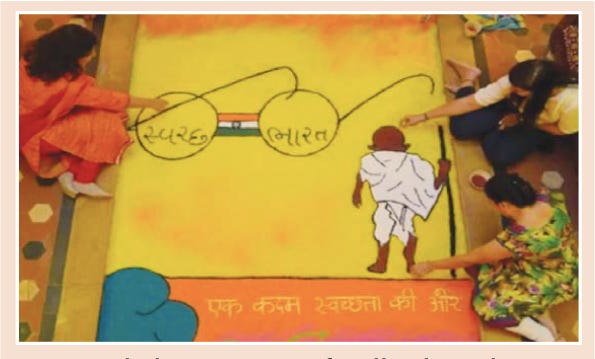Clean .... inside or outside?
Humorous observations taunt people in India and Asia as dirty. This is done both by Indians in India, Indians in the diaspora, and foreigners! Indeed, Indian streets are filled with litter in many many parts of the country; the land just outside the home is not maintained for easy access, and the buildings are not washed, painted or beautified. In contrast, westerners place priority on keeping the streets clean and neighborhoods and houses beautiful. Furniture is well-constructed and placed well inside homes, the walls are painted, the cars are shiny. The assumption is that emulating western practices means being clean and showing the world how clean is better.
Observant Indians will rebut that while it is true that the streets of India and the houses may not be clean and shiny, the ancient habits living in the modern culture of today emphasizes cleaning the inside, because that is within an individual's control, whereas cleaning the outside is often a complex and unruly amalgam of many factors. Perhaps that is why people have given up on the outside world that they cannot control. Perhaps their sense of environment is different than western concepts. Perhaps they are just self-centered.
A person cleaning the street outside the house in urban India is denigrated as a sweeper, so the tidy have to clean public areas secretly. Repairs to common areas are considered not a private person's responsibility. Indeed, the most prominent politicians cast their paan packets aside and use plenty of water bottles without regard to recycling or environmental concerns.
Traditionalists following Bharaitya sciences however will counter that Europeans and Americans are clean on the outside but filled with dirt and ama inside and their bathrooms smell filthy. They have poor daily hygiene routines, and rarely wash their clothes. Their sexual habits are untidy, and even the educated litter their bodies with recreational drugs.
Overall, western habits are ignorant and superficially clean, not aware of the inner and deeper meanings of keeping those things out that create imbalances or interruptions between the body, mind, senses and soul. Because the focus is on chemicals and material awareness, energetic being is not emphasized. On the contrary, whereas Indians might live in dense populations and have incessant litter on the streets, the focus remains on cleaning the inside and the priority on keeping a clean home inside not outside.
Some of this is a remnant of being ruled by invaders for the past 600 years. Common areas were usurped by the Moghuls and the Europeans, leaving the common Indian without their community and town as their responsibility, but only their own home. Anything that appeared wealthy was taxed, stolen, looted by the invaders. Hiding one's wealth meant pretending and masking by appearing neglected, unhealthy and unwealthy, so that destructive and greedy rulers would not come hunting for treasures.
These treasures were carefully kept inside inner chambers. Similarly, people were targeted and enslaved if they had anything of value, such as talents in mathematics, keen senses, beauty, brawn, or skills. So they hid their children, the beauty of their blooming sons and daughters, and the talents and artisanship of the family.
When westerners speak spitefully of the unwillingness of Indian masters to share their arts of healing, as though they have a right to the skills of treating cancers with plants, or curing incurable states of diabetes, heart ailments, asthma, or colitis, the ayurvedic vaidyas often counter that they do not want to participate in being exploited by people looking only to make a profit. They lead quiet, uninterrupted lives in rural areas, and share their traditionally-received wisdom through traditional means of teaching. They hide because the treasures of their knowledge are considered commodities.
The ways of traditional wisdom sharing require students to be worthy, by demonstrating the understanding of Clean. Their daily routines, when, what and how they study, how they keep not only their homes, but the area around, how they feed birds and animals nearby, their use of utensils, how they select food and cook, how they keep their kitchen, their bed, and their bath and toilet, are observed by the master. Their daily and weekly hygiene practices, how they do laundry, their sexual habits, and how they repair themselves when they are tired tell whether they understand the principles of ama and flow. Aligning with the energy of the universe after understanding the nature of material and non-material existence is clean. Only then can the master pour wisdom into the clean cup that is the vessel of the student's being.
week 120. TheSouthAsianTimes
Download the .pdf version of this column by clicking on the image.
Dr. Bhaswati Bhattacharya is a Fulbright Specialist 2018‐2023 in Public Health, a family physician in the Department of Medicine at Weill Cornell Medical College in New York, NY, and holds doctorates in pharmacology and Ayurveda. She teaches ayurvedic nutrition on global platforms and cleans her channels regularly with sesame oil, mustard oil, and ghee.
Her bestselling book Everyday Ayurveda is published by Penguin Random House.
To order an autographed copy, write to bhaswati@post.harvard.edu.
To learn more, visit www.drbhaswati.com






